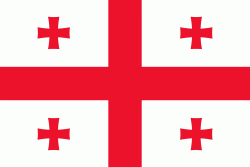Gurjaani Municipality (Gurjaanis Munitsip’alit’et’i)
Gurjaani (გურჯაანის მუნიციპალიტეტი, Gurjaanis municiṗaliṫeṫi) is an administrative-territorial unit in eastern Georgia, Kakheti region. Until 1917, the territory of Gurjaani municipality was part of Telavi Mazra of Tbilisi Governorate; since 1921 it has been included in Telavi Mazra; Since 1930, it has been an independent district in Kakheti district, then it became a separate district. It has been a municipality since 2006.
The population was 54,337 as of the 2014 census, and it has an area of 846 km2.
Gurjaani is a municipality located in the Kakheti region. It has been inhabited since ancient times; a stone age human settlement has been discovered. The municipality's territory was densely populated both in the Bronze Age and the Ancient and Feudal Ages. The name Gurjaani has a Turkish origin: the word "Gurj" is Turkish and means Georgian, and "Gurjaani" means a settlement of Georgians.
A large part of the territory of Gurjaani municipality was within Hereti under Saeristavo (principality) of Vejini. From the 70s of the 15th centuries, after the abolition of the principalities in Kakheti, there were several shrines (of Vejini, Veliszikhe, Kalauri, Shashiani, Akhasheni, Jimiti, Chumlaki and others).
The population was 54,337 as of the 2014 census, and it has an area of 846 km2.
Gurjaani is a municipality located in the Kakheti region. It has been inhabited since ancient times; a stone age human settlement has been discovered. The municipality's territory was densely populated both in the Bronze Age and the Ancient and Feudal Ages. The name Gurjaani has a Turkish origin: the word "Gurj" is Turkish and means Georgian, and "Gurjaani" means a settlement of Georgians.
A large part of the territory of Gurjaani municipality was within Hereti under Saeristavo (principality) of Vejini. From the 70s of the 15th centuries, after the abolition of the principalities in Kakheti, there were several shrines (of Vejini, Veliszikhe, Kalauri, Shashiani, Akhasheni, Jimiti, Chumlaki and others).
Map - Gurjaani Municipality (Gurjaanis Munitsip’alit’et’i)
Map
Country - Georgia_(country)
 |
 |
| Flag of Georgia (country) | |
During the classical era, several independent kingdoms became established in what is now Georgia, such as Colchis and Iberia. In the early 4th century, ethnic Georgians officially adopted Christianity, which contributed to the spiritual and political unification of the early Georgian states. In the Middle Ages, the unified Kingdom of Georgia emerged and reached its Golden Age during the reign of King David IV and Queen Tamar in the 12th and early 13th centuries. Thereafter, the kingdom declined and eventually disintegrated under the hegemony of various regional powers, including the Mongols, the Turks, and various dynasties of Persia. In 1783, one of the Georgian kingdoms entered into an alliance with the Russian Empire, which proceeded to annex the territory of modern Georgia in a piecemeal fashion throughout the 19th century.
Currency / Language
| ISO | Currency | Symbol | Significant figures |
|---|---|---|---|
| GEL | Georgian lari | ₾ | 2 |
| ISO | Language |
|---|---|
| HY | Armenian language |
| AZ | Azerbaijani language |
| KA | Georgian language |
| RU | Russian language |















